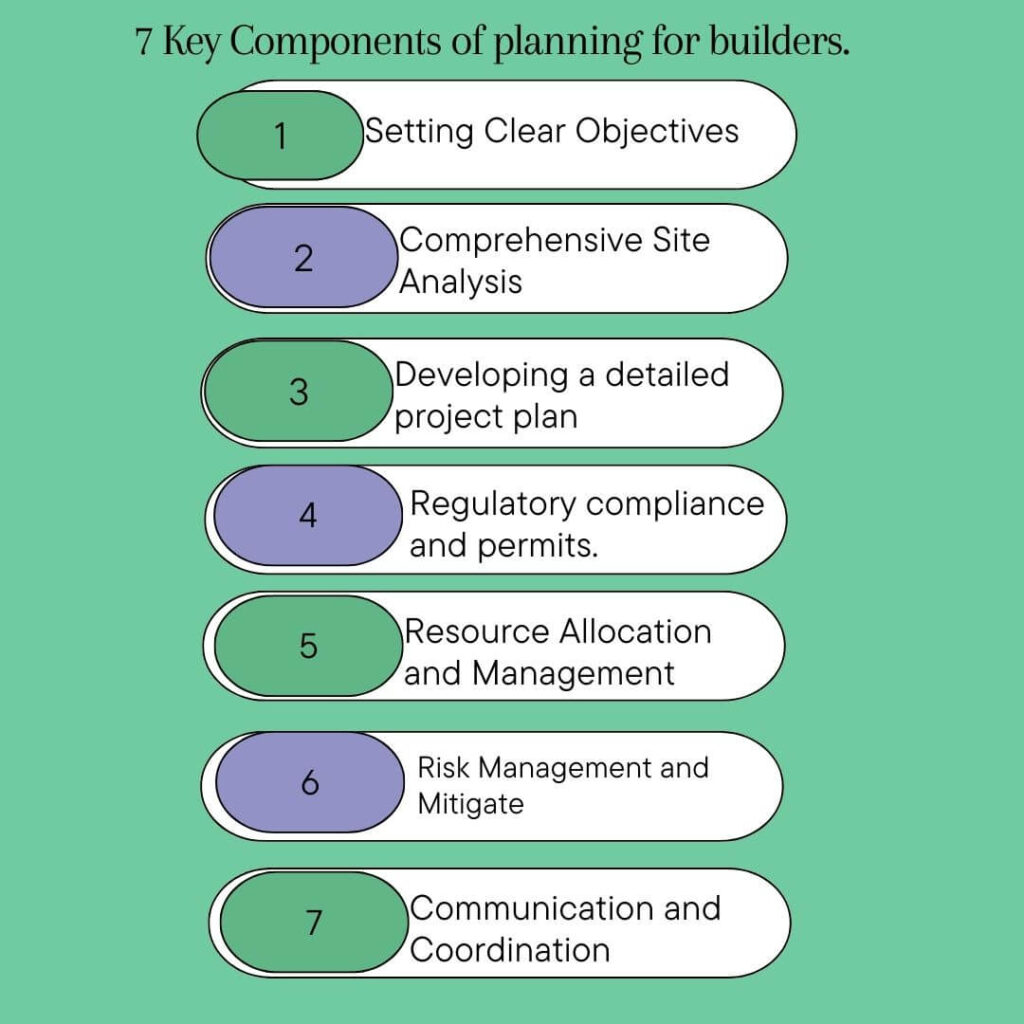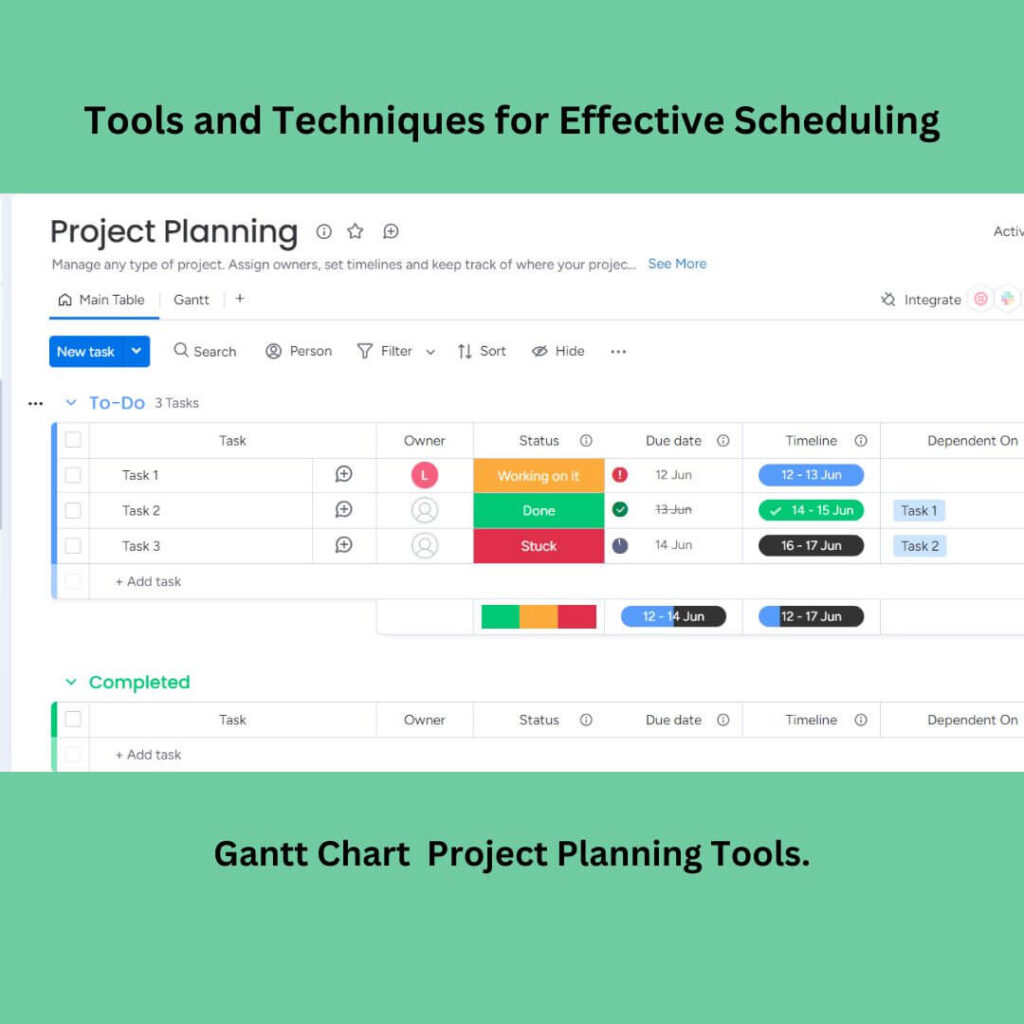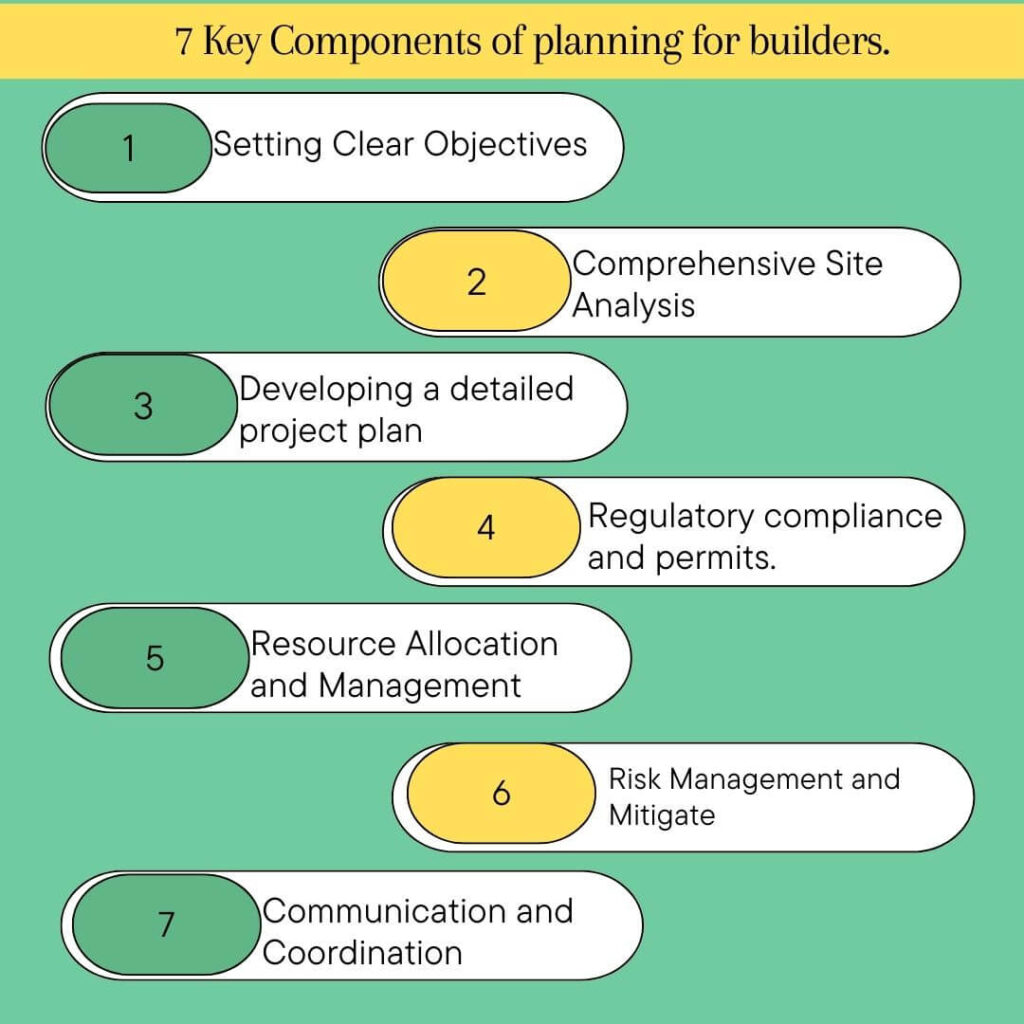Planning is the cornerstone of any successful construction project. A builder needs to meticulously plan to avoid mistakes and get few surprises. He must streamline his operations. Proper planning will ultimately lead to a project that is completed on time and within budget. Without a solid plan, even the most skilled builders can find themselves facing delays, cost overruns, and dissatisfied clients. Therefore, the query is: What are the key components of planning? is appropriate for a builder who want to be successful in his career. The knowledge of key components of planning will guide him in making appropriate plans towards achieving success in any of his projects.
In this blog, I will delve into the seven key components of planning that every builder should master. From setting clear objectives to navigating regulatory compliance, each aspect plays a critical role in ensuring the success of a construction project.
What are the key components of planning?
The key components of planning in the construction industry include:
- Setting clear objectives
- Conducting comprehensive site analysis
- Developing a detailed project plan
- Regulatory compliance and permits
- Resource allocation and management
- Risk management and mitigation
- Communication and coordination

1. Setting Clear Objectives
The foundation of any construction project is a set of well-defined objectives. These objectives serve as the guiding light for a site manager. They help to align the efforts of everyone involved. Clear and measurable goals ensure that all stakeholders have a unified vision and aid you in tracking progress effectively.
- Importance of Having Clear and Measurable Objectives
When you have clear and measurable objectives, they will provide a benchmark for your success. clear objectives enable builders to assess performance and make necessary adjustments throughout the project lifecycle. Moreover, they also help in managing client expectations, ensuring that the final outcome aligns with the initial vision.
- Examples of Common Construction Project Goals
Common goals in construction projects may include completing the project by a certain date, staying within a specified budget, achieving a particular quality standard, and ensuring safety compliance. For instance, a goal might be to complete a residential building within 12 months, maintain a budget of $5 million, and adhere to all safety regulations.

Comprehensive Site Analysis
A thorough site analysis is critical in the planning phase of a construction project. It provides vital information that influences the project’s design, timeline, and budget. site analysis can be conducted through soil tests, environmental assessment, accessibility and logistics
- Conducting Soil Tests and Environmental Assessments
Soil tests are essential to determining the suitability of the site for construction. They help identify any potential issues with soil stability, drainage, and composition that could affect the project’s foundation. If this is done properly, it will avert the issue of building collapse in the future. Environmental assessments, on the other hand, ensure that the construction activities will not have a detrimental impact on the local ecosystem. It will ensure compliance to all the local policies guiding environmental factors on site building
- Evaluating Site Accessibility and Logistics
Assessing the site’s accessibility is another crucial component. It involves evaluating how easy it is to transport materials and equipment to the site and identifying any potential logistical challenges. This step helps in planning for efficient movement of resources, reducing delays, and ensuring smooth operations.
Developing a Detailed Project Plan
A detailed project plan is a blueprint for successful execution. It outlines the sequence of tasks, allocates resources, and sets deadlines.
- Importance of Creating a Realistic Project Timeline
A realistic timeline is essential for managing expectations and ensuring that all phases of the project are completed on schedule. It helps in identifying critical paths and potential bottlenecks, allowing for proactive management.
- Tools and Techniques for Effective Scheduling
Several tools and techniques can aid in effective scheduling. Gantt charts, for example, provide a visual representation of the project timeline, showing the start and end dates of each task. Critical Path Method (CPM) and Program Evaluation and Review Technique (PERT) are also valuable for identifying the most crucial tasks and ensuring that they are completed on time.
- Budgeting and Cost Estimation
Budgeting and cost estimation are fundamental to the success of construction projects. It provide a financial framework that ensures efficient resources allocation while potential cost overruns are mitigated. A well-planned budget is the cornerstone of any construction project. Accurate cost estimation ensures that the project remains financially viable. These processes involve initial rough estimates, detailed cost estimations through quantity takeoffs, unit pricing, and vendor quotes. To get an accurate budget and cost estimation you can leverage historical data and utilizes specialized software tools, such as Bluebeam and PlanSwift, to enhances the accuracy of your estimations.
Comprehensive budgeting includes direct and indirect costs, as well as contingency funds to cover unexpected expenses, ensuring a realistic financial plan. Accurate cost estimation on the other hands involves considering all potential expenses, including materials, labor, equipment, permits, and contingency funds. Builders should use historical data, vendor quotes, and detailed takeoffs to develop a comprehensive budget.
- Managing Project Budgets and Financial Planning
Effective financial planning involves continuous monitoring of expenditures and making adjustments as necessary. Builders should track costs against the budget, identify any variances, and take corrective action promptly. This proactive approach helps maintain financial control throughout the project lifecycle.

4. Regulatory compliance and permits.
One of the good criteria for project planning is to obtain the necessary permits. It’s a critical step in the planning phase. This process involves submitting detailed plans and documentation to the relevant authorities for approval. Builders should factor in the time required for permit approval into their project timeline to avoid delays.
- Building Codes
Similar to permits is compliance with local building codes and regulations. This is non-negotiable in any construction project. Failure to adhere to these standards can result in legal issues, fines, and project delays. Builders must have a thorough understanding of the building codes applicable to their project. These codes cover various aspects, including structural integrity, fire safety, electrical systems, and plumbing. Staying informed about any updates or changes to these regulations is also crucial.
5. Resource Allocation and Management
As you have learned in budget and cost estimation, efficient resource allocation is vital for the smooth execution of a construction project. It involves ensuring that the right people and materials are available at the right time. Resources in this regard is manpower and materials.
- Efficient Allocation of Manpower and Resources
Proper manpower management ensures that skilled workers are available for each phase of the project. This involves scheduling labor in a way that maximizes productivity and minimizes downtime. Resource management also includes coordinating the delivery of materials to avoid shortages or excess inventory.
- Ensuring Timely Procurement of Materials
Timely procurement of materials is essential to keeping the project on track. Builders should establish reliable supplier relationships and use procurement management systems to streamline the process. This helps in avoiding delays caused by material shortages and ensures that the project progresses as planned.
6. Risk Management and mitigation
Every construction project comes with its own set of risks. As a good planner, you must be able to identify these risks early and develop mitigation strategies to minimize their impact. Some common risks in construction projects include weather-related delays, safety incidents, supply chain disruptions, and unforeseen site conditions. Also the prevalent risk similar to the one mentioned is financial risks, such as cost overruns and funding issues. All these risks must be managed well and planned for by the builders.
- Techniques for Risk Assessment and Mitigation
Risk assessment involves evaluating the likelihood and impact of potential risks. Builders can use tools like risk matrices and SWOT analysis to prioritize risks and develop mitigation plans. Contingency planning and insurance are also important components of risk management, providing a safety net for unexpected events.
7. Communication and Coordination
Effective communication is the glue that holds a construction project together. It ensures that all stakeholders are on the same page and that any issues are addressed promptly.
- importance of Effective Communication Among Stakeholders
Clear communication helps in avoiding misunderstandings and conflicts. It ensures that everyone involved in the project, from clients to subcontractors, understands their roles and responsibilities. Regular meetings and updates help keep all parties informed about the project’s progress and any changes.
- Tools for Facilitating Communication and Collaboration
Several tools can enhance communication and collaboration in construction projects. Project management software, like Procore and the Builder trend, offer features for task management, document sharing, and real-time updates. Communication platforms, such as Slack and Microsoft Teams, facilitate instant messaging and video conferencing, keeping everyone connected.
Planning is the backbone of any successful construction project. By setting clear objectives, conducting comprehensive site analyses, developing detailed project plans, ensuring regulatory compliance, managing resources efficiently, mitigating risks, and fostering effective communication, builders can navigate the complexities of construction projects with confidence.
On a final note, thorough planning is not just about creating a roadmap; it’s about anticipating challenges and preparing solutions in advance. It empowers builders to deliver projects that meet or exceed client expectations while staying within budget and on schedule. In the ever-evolving construction industry, the ability to plan meticulously is what sets successful builders apart
FAQs
Common Questions About Construction Planning
- Q: What is the most critical aspect of construction planning?
A: While all components are important, setting clear objectives and developing a detailed project plan are often considered the most critical as they lay the foundation for all other planning activities.
- Q: How can I improve my cost estimation accuracy?
A: Use historical data, consult with experts, and employ detailed takeoff methods. Tools like BIM (Building Information Modeling) can also enhance accuracy.
- Q: What should I do if I encounter an unexpected regulatory requirement?
A: Address it immediately by consulting with regulatory experts and adjusting your plan accordingly. Keeping an open line of communication with local authorities can also help in navigating unforeseen requirements.
- Q: How do I ensure effective communication in my project?
A: Establish clear communication channels from the start, use project management and communication tools, and hold regular meetings to keep all stakeholders informed.
Feel free to contact us if you are ready to buy a new home or if you want us to supervise your project. We promise to deliver a timely and mouth-watering home built with high-quality materials. You can reach us on 07057233081

Hikmat Olomo is a dedicated real estate enthusiast with a strong foundation in building and construction. Her deep dive into the real estate industry has equipped her with knowledge about market trends, property investment strategies, and home-buying tips. Hikmat’s background in real estate allows her to effectively analyze market data and present it in a way that is both insightful and accessible to her readers. As this blog’s author, she is committed to delivering valuable, up-to-date information to help readers make informed decisions in the ever-changing real estate market.
